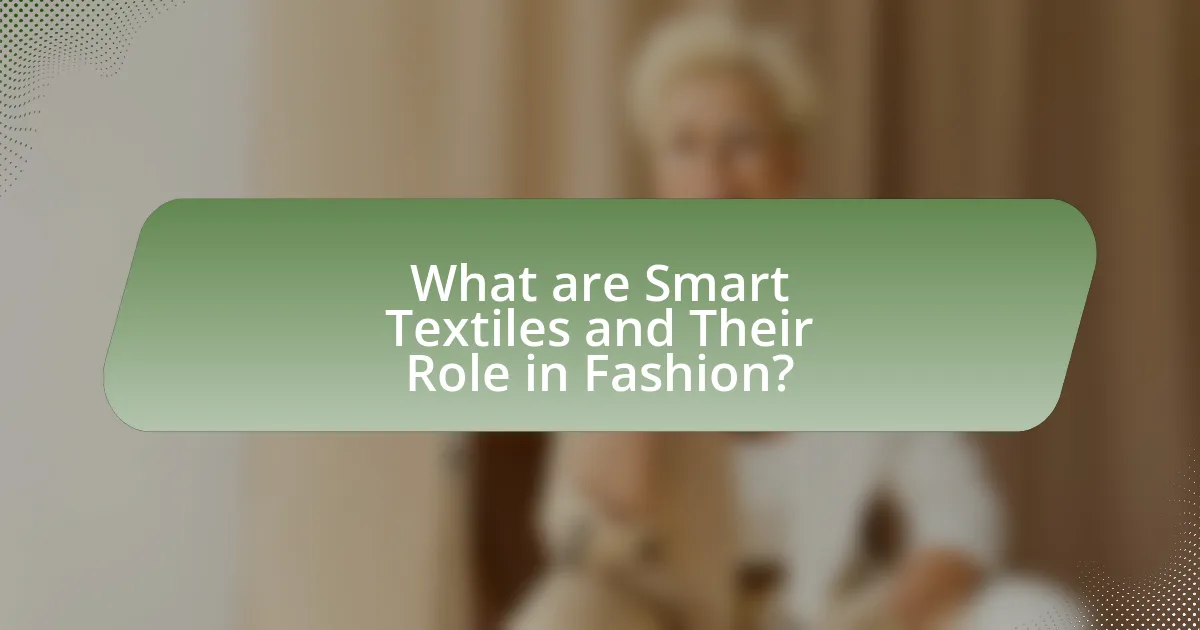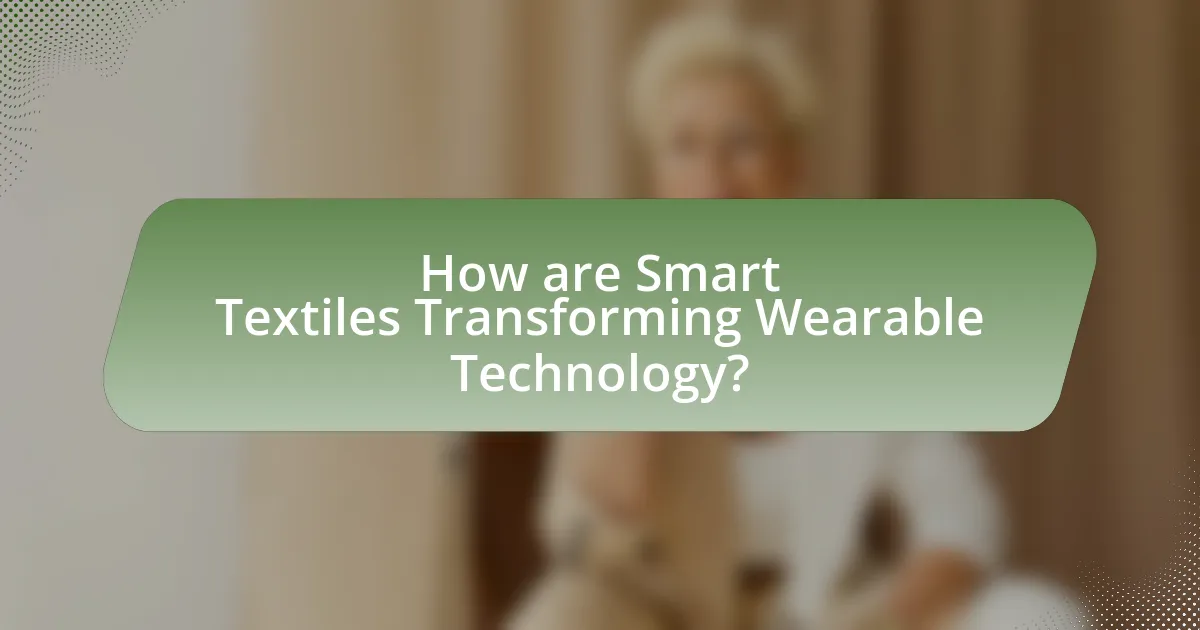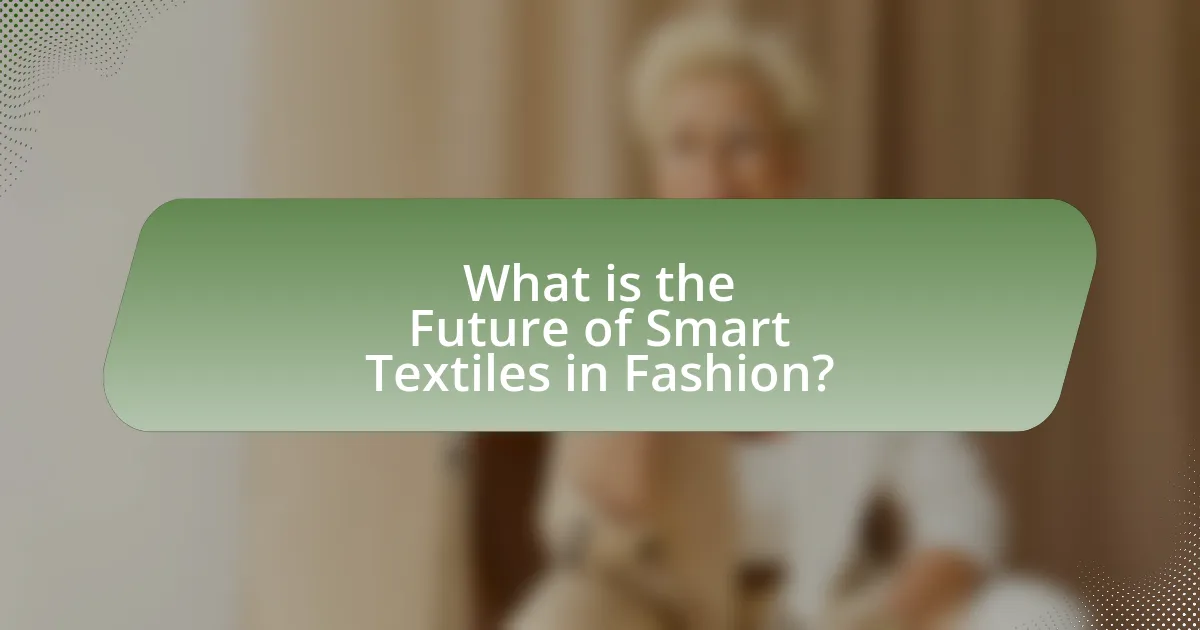Smart textiles are innovative fabrics embedded with technology that enable them to sense and respond to environmental stimuli, significantly enhancing functionality in fashion. This article explores the differences between smart textiles and traditional fabrics, detailing the technologies integrated into them, such as conductive fibers and sensors, which enhance user experience through health monitoring and temperature regulation. It also discusses the benefits of smart textiles, including sustainability and personalization, while addressing challenges like high production costs and consumer acceptance. The future of smart textiles in fashion is highlighted, showcasing emerging trends and the impact of consumer preferences on their development and adoption.

What are Smart Textiles and Their Role in Fashion?
Smart textiles are fabrics embedded with technology that enables them to sense and respond to environmental stimuli, enhancing functionality in fashion. These textiles can monitor health metrics, adjust temperature, or change color based on external conditions, thereby integrating technology seamlessly into clothing. For instance, a study published in the journal “Textile Research Journal” highlights that smart textiles can improve athletic performance by providing real-time feedback on body metrics. This innovative approach not only transforms the functionality of garments but also opens new avenues for personalization and user interaction in the fashion industry.
How do Smart Textiles differ from traditional fabrics?
Smart textiles differ from traditional fabrics primarily in their ability to interact with the environment and respond to stimuli. While traditional fabrics are static and lack functionality beyond basic wearability, smart textiles incorporate technology such as sensors, actuators, and conductive materials that enable them to monitor health metrics, change properties, or provide feedback. For example, smart textiles can regulate temperature, track physical activity, or even deliver electrical signals, which traditional fabrics cannot do. This integration of technology into the fabric structure allows for innovative applications in fields like healthcare, sports, and fashion, demonstrating a significant advancement over conventional textiles.
What technologies are integrated into Smart Textiles?
Smart textiles integrate various technologies, including conductive fibers, sensors, microcontrollers, and wireless communication systems. Conductive fibers enable the transmission of electrical signals, while sensors can monitor physiological parameters such as heart rate and temperature. Microcontrollers process the data collected by sensors, and wireless communication systems allow for data transmission to external devices, enhancing functionality and user interaction. These technologies collectively enable smart textiles to respond to environmental stimuli and user needs, making them a significant advancement in wearable technology.
How do these technologies enhance functionality?
Smart textiles enhance functionality by integrating advanced materials and technologies that respond to environmental stimuli. These textiles can monitor physiological parameters, such as heart rate and temperature, providing real-time data to users. For instance, a study published in the journal “Advanced Functional Materials” demonstrates that smart textiles can incorporate sensors that detect changes in body temperature, allowing for adaptive thermal regulation. This capability not only improves comfort but also enhances performance in various activities, such as sports and outdoor adventures. Additionally, smart textiles can facilitate communication through embedded electronics, enabling seamless interaction with devices, which further expands their utility in everyday life.
What are the key benefits of Smart Textiles in fashion?
Smart textiles in fashion offer enhanced functionality, comfort, and personalization. These textiles can monitor health metrics, such as heart rate and temperature, providing real-time data to users. For instance, a study published in the journal “Advanced Materials” highlights that smart textiles can integrate sensors that track physiological signals, improving athletic performance and health monitoring. Additionally, smart textiles can adapt to environmental conditions, offering temperature regulation and moisture management, which enhances user comfort. The integration of these technologies not only elevates the user experience but also opens new avenues for innovation in fashion design and sustainability.
How do Smart Textiles improve user experience?
Smart textiles improve user experience by integrating technology into fabrics, enabling functionalities such as temperature regulation, moisture management, and health monitoring. These textiles enhance comfort and performance by adapting to environmental conditions and user needs, such as maintaining optimal body temperature during physical activities. For instance, a study published in the Journal of Textile Science and Technology highlights that smart textiles can actively respond to sweat levels, providing real-time feedback and improving overall comfort for the wearer. This adaptability not only enhances physical performance but also contributes to a more personalized and engaging user experience.
What environmental benefits do Smart Textiles offer?
Smart textiles offer significant environmental benefits by promoting sustainability through reduced waste and energy consumption. These textiles can be designed to be biodegradable or made from recycled materials, minimizing landfill contributions. Additionally, smart textiles often incorporate energy-harvesting technologies, such as solar fibers, which can reduce reliance on non-renewable energy sources. Research indicates that the integration of smart textiles in clothing can lead to a decrease in the frequency of washing and drying, thereby conserving water and energy. For instance, a study published in the Journal of Cleaner Production highlights that smart textiles can reduce the environmental impact of the fashion industry by up to 30% through these efficiencies.

How are Smart Textiles Transforming Wearable Technology?
Smart textiles are transforming wearable technology by integrating advanced functionalities such as health monitoring, temperature regulation, and energy harvesting into fabrics. These textiles utilize conductive fibers and sensors to collect data on physiological parameters, enabling real-time health tracking and personalized feedback. For instance, a study published in the journal “Nature” highlights how smart textiles can monitor heart rate and body temperature, providing critical insights for athletes and patients alike. Additionally, smart textiles can adapt to environmental changes, enhancing user comfort and performance, as demonstrated by the development of fabrics that adjust insulation based on body heat. This innovation not only improves the functionality of wearable devices but also expands their applications across various fields, including healthcare, sports, and fashion.
What types of Smart Textiles are currently available?
Currently, there are several types of smart textiles available, including conductive textiles, phase change materials, and e-textiles. Conductive textiles incorporate conductive fibers that enable the integration of electronic components, allowing for functionalities such as sensing and communication. Phase change materials are designed to regulate temperature by absorbing, storing, and releasing heat, enhancing comfort in varying environmental conditions. E-textiles, or electronic textiles, combine traditional fabrics with electronic components to create garments that can monitor health metrics, provide feedback, or interact with other devices. These categories reflect the diverse applications and innovations within the smart textiles industry, which is rapidly evolving to meet consumer demands and technological advancements.
How do conductive fabrics work in wearable technology?
Conductive fabrics work in wearable technology by integrating conductive materials, such as metal fibers or conductive polymers, into textiles to create pathways for electrical signals. These fabrics enable the transmission of data and power, allowing for functionalities like monitoring physiological signals, controlling devices, and providing haptic feedback. For instance, research has shown that conductive fabrics can be used in smart clothing to track heart rate and body temperature, enhancing health monitoring capabilities in wearable devices.
What are the applications of phase change materials in clothing?
Phase change materials (PCMs) in clothing are primarily used for thermal regulation, allowing garments to absorb, store, and release heat to maintain a comfortable temperature for the wearer. These materials can be integrated into fabrics to enhance comfort in varying environmental conditions, making them ideal for activewear, outdoor clothing, and smart textiles. For instance, PCMs can be embedded in fibers or coatings, enabling clothing to adapt to body temperature changes during physical activities, thereby improving performance and comfort. Research has shown that garments incorporating PCMs can significantly reduce temperature fluctuations, providing a more stable microclimate for the wearer.
What challenges do Smart Textiles face in the fashion industry?
Smart textiles face several challenges in the fashion industry, including high production costs, durability issues, and consumer acceptance. High production costs arise from the complex materials and technologies required to create smart textiles, making them less accessible to mass markets. Durability issues stem from the integration of electronic components, which can affect the lifespan and washability of garments. Additionally, consumer acceptance is hindered by a lack of awareness and understanding of the benefits of smart textiles, as well as concerns about privacy and data security associated with wearable technology. These challenges must be addressed for smart textiles to gain wider adoption in the fashion industry.
How do manufacturing costs impact the adoption of Smart Textiles?
Manufacturing costs significantly impact the adoption of Smart Textiles by influencing pricing, accessibility, and market demand. High manufacturing costs can lead to elevated retail prices, making Smart Textiles less accessible to consumers and limiting widespread adoption. For instance, a study by the Textile Research Journal indicates that the integration of advanced materials and technology in Smart Textiles can increase production costs by up to 30%, which directly affects consumer purchasing decisions. Consequently, lower manufacturing costs could enhance affordability, stimulate demand, and promote broader acceptance of Smart Textiles in the fashion industry.
What are the limitations in current Smart Textile technologies?
Current Smart Textile technologies face several limitations, including high production costs, limited durability, and challenges in integrating electronics with textiles. High production costs hinder widespread adoption, as advanced materials and manufacturing processes are often expensive. Limited durability affects the longevity of smart textiles, as they may not withstand regular wear and washing. Additionally, challenges in integrating electronics with textiles can lead to issues such as discomfort for the wearer and reduced functionality, as seen in studies highlighting the difficulties of maintaining performance while ensuring comfort.

What is the Future of Smart Textiles in Fashion?
The future of smart textiles in fashion is poised for significant growth, driven by advancements in technology and increasing consumer demand for functionality and sustainability. Innovations such as conductive fibers, sensors, and responsive materials are enabling garments to monitor health metrics, adapt to environmental conditions, and enhance user experience. According to a report by Research and Markets, the global smart textiles market is expected to reach $5.3 billion by 2024, reflecting a compound annual growth rate of 27.4% from 2019. This growth is fueled by applications in sports, healthcare, and everyday wear, indicating a shift towards integrating technology seamlessly into clothing.
How are designers incorporating Smart Textiles into their collections?
Designers are incorporating Smart Textiles into their collections by integrating fabrics that can respond to environmental stimuli, such as temperature and moisture. This integration allows for the creation of garments that can regulate body temperature, enhance comfort, and improve performance in various activities. For instance, brands like Nike and Under Armour have developed moisture-wicking fabrics that adapt to the wearer’s sweat levels, providing a more comfortable experience during physical exertion. Additionally, designers are utilizing conductive fibers to enable functionalities like health monitoring and connectivity, exemplified by the use of smart sensors embedded in clothing to track biometric data. This trend reflects a growing emphasis on functionality and innovation in fashion, aligning with consumer demand for technologically advanced apparel.
What trends are emerging in Smart Textile fashion design?
Emerging trends in Smart Textile fashion design include the integration of sustainability, enhanced functionality, and personalization. Designers are increasingly focusing on eco-friendly materials and processes, as evidenced by the rise of biodegradable fabrics and recycled fibers, which cater to the growing consumer demand for sustainable fashion. Additionally, advancements in technology are enabling textiles to incorporate features such as temperature regulation, moisture-wicking, and even health monitoring, allowing garments to adapt to the wearer’s needs. Personalization is also a key trend, with brands utilizing data analytics to create customized designs and fit, enhancing user experience. These trends reflect a shift towards more innovative, functional, and environmentally conscious fashion solutions.
How are consumer preferences shaping the future of Smart Textiles?
Consumer preferences are significantly shaping the future of smart textiles by driving demand for functionality, sustainability, and personalization. As consumers increasingly prioritize comfort and performance in their clothing, manufacturers are responding by integrating advanced technologies that enhance wearability, such as moisture-wicking fabrics and temperature regulation. Additionally, the growing awareness of environmental issues has led consumers to favor sustainable materials and production processes, prompting brands to innovate with eco-friendly smart textiles. Market research indicates that 60% of consumers are willing to pay more for sustainable products, highlighting the importance of eco-conscious choices in shaping industry trends. Furthermore, the desire for personalized experiences is leading to the development of customizable smart textiles that cater to individual preferences, such as color, fit, and embedded technology features. This shift in consumer behavior is driving the evolution of smart textiles, making them more aligned with the values and needs of modern consumers.
What practical tips can consumers consider when choosing Smart Textiles?
When choosing smart textiles, consumers should prioritize functionality, comfort, and compatibility with their lifestyle. Functionality is crucial; consumers should assess the specific features offered, such as moisture-wicking, temperature regulation, or health monitoring capabilities. Comfort is equally important, as smart textiles should feel good against the skin and allow for ease of movement. Compatibility with existing devices, such as smartphones or fitness trackers, ensures that the smart textile can integrate seamlessly into the consumer’s daily routine. Additionally, consumers should consider the care instructions and durability of the fabric, as these factors impact long-term usability. Research indicates that smart textiles can enhance user experience when they meet these practical criteria, making informed choices essential for satisfaction and performance.
How can consumers ensure the quality of Smart Textile products?
Consumers can ensure the quality of Smart Textile products by researching the manufacturer’s reputation and verifying product certifications. Established brands often provide detailed information about their materials, technology, and testing processes, which can indicate reliability. Additionally, consumers should look for third-party certifications, such as Oeko-Tex or ISO standards, which confirm that the textiles meet specific safety and performance criteria. Reviews and testimonials from other users can also provide insights into the product’s durability and functionality, further aiding in the assessment of quality.
What maintenance practices are recommended for Smart Textiles?
Recommended maintenance practices for smart textiles include gentle washing, avoiding harsh detergents, and ensuring proper drying methods. Gentle washing helps preserve the electronic components embedded in the fabric, while harsh detergents can damage these components. Proper drying methods, such as air drying instead of using a dryer, prevent heat damage. Additionally, regular inspections for wear and tear are essential to maintain functionality and safety. These practices are crucial for extending the lifespan and performance of smart textiles, which often integrate sensitive technology within their fibers.




